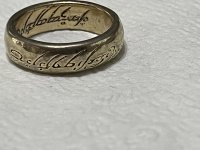BeerBottleTom
Greenie
This May 2008 photo provided by Terri Deming shows a rusted box containing Depression-era currency found by her husband Dan at their farm near Briggsville, Wisc. Dan Deming had heard the rumors of treasure buried somewhere on his central Wisconsin farmland but he was never sure whether to believe them. The 34-year-old electrician was tearing down a 100-year-old shed on his farm recently when this rusted box tumbled from the rubble revealing wads of deteriorated $1s, $5s, $10s and $20s. (AP Photo/Terri Deming)
Man unearths box filled with Depression-era cash
Monday, June 2, 2008 6:35 AM EDT
The Associated Press
By DINESH RAMDE Associated Press Writer
MILWAUKEE (AP) — Dan Deming had heard the rumors about the buried treasure on his central Wisconsin farm.
At first he made some halfhearted attempts to find it, and then searched in earnest for two or three years after receiving a metal detector for his birthday.
"I don't know what I thought, if I thought it was really there or not," he said.
The mystery ended recently while Deming was tearing down a 100-year-old shed on his property. A rusted box tumbled from the rubble and wads of currency dating back to the Depression spilled on the ground.
"I couldn't believe it. I started running to the house with it," Deming, 34, said Sunday. "My wife thought I broke my arm because I was just hooting and hollering."
The bills were so deteriorated that it was hard to count the money. But the box also contained scraps of newspaper with dollar amounts written on them, a possible tally of the loot.
Deming briefly considered selling the bills to collectors, but the money was in poor condition. Instead, he turned it over to the U.S. Treasury's Bureau of Engraving and Printing, which redeems mutilated currency for face value, he said.
"I'm hoping it'll be for $1,700 because that's what the paper said," Deming said. "It's hard to say, though. It's really difficult to tell what was in there."
The legend of the buried treasure dates back more than 40 years.
"I heard from my grandfather that a man who lived here during the '30s and '40s was eccentric and might have stashed money," Deming said.
When he first saw the bills, he thought they were play money. Then he saw the words "silver certificate" across the top of a $1 bill and realized it was real. He also noticed the bills were dated between 1928 and 1934.
Deming says he'll use whatever money he gets from the Bureau of Engraving and Printing to build a replacement shed.
He also plans to tear down a rickety old barn on his land, and wondered for a fleeting moment whether there might be more money stashed there.
"I'm hoping maybe there's something there — but I doubt it," he said. "I mean, $1,700 during the Depression was probably this guy's life savings."
Man unearths box filled with Depression-era cash
Monday, June 2, 2008 6:35 AM EDT
The Associated Press
By DINESH RAMDE Associated Press Writer
MILWAUKEE (AP) — Dan Deming had heard the rumors about the buried treasure on his central Wisconsin farm.
At first he made some halfhearted attempts to find it, and then searched in earnest for two or three years after receiving a metal detector for his birthday.
"I don't know what I thought, if I thought it was really there or not," he said.
The mystery ended recently while Deming was tearing down a 100-year-old shed on his property. A rusted box tumbled from the rubble and wads of currency dating back to the Depression spilled on the ground.
"I couldn't believe it. I started running to the house with it," Deming, 34, said Sunday. "My wife thought I broke my arm because I was just hooting and hollering."
The bills were so deteriorated that it was hard to count the money. But the box also contained scraps of newspaper with dollar amounts written on them, a possible tally of the loot.
Deming briefly considered selling the bills to collectors, but the money was in poor condition. Instead, he turned it over to the U.S. Treasury's Bureau of Engraving and Printing, which redeems mutilated currency for face value, he said.
"I'm hoping it'll be for $1,700 because that's what the paper said," Deming said. "It's hard to say, though. It's really difficult to tell what was in there."
The legend of the buried treasure dates back more than 40 years.
"I heard from my grandfather that a man who lived here during the '30s and '40s was eccentric and might have stashed money," Deming said.
When he first saw the bills, he thought they were play money. Then he saw the words "silver certificate" across the top of a $1 bill and realized it was real. He also noticed the bills were dated between 1928 and 1934.
Deming says he'll use whatever money he gets from the Bureau of Engraving and Printing to build a replacement shed.
He also plans to tear down a rickety old barn on his land, and wondered for a fleeting moment whether there might be more money stashed there.
"I'm hoping maybe there's something there — but I doubt it," he said. "I mean, $1,700 during the Depression was probably this guy's life savings."





